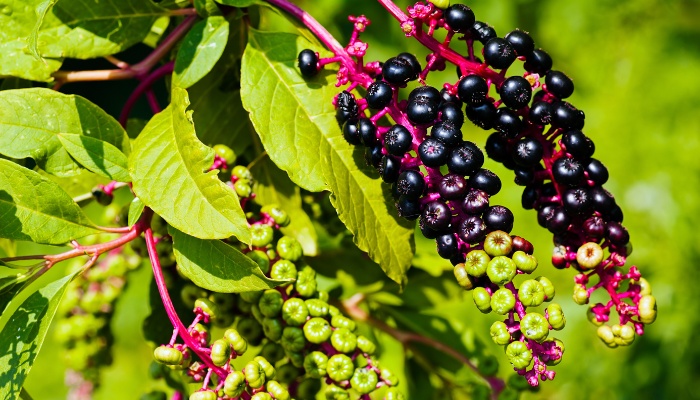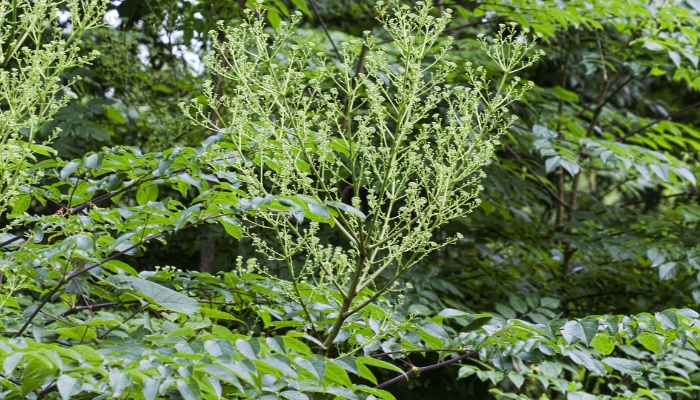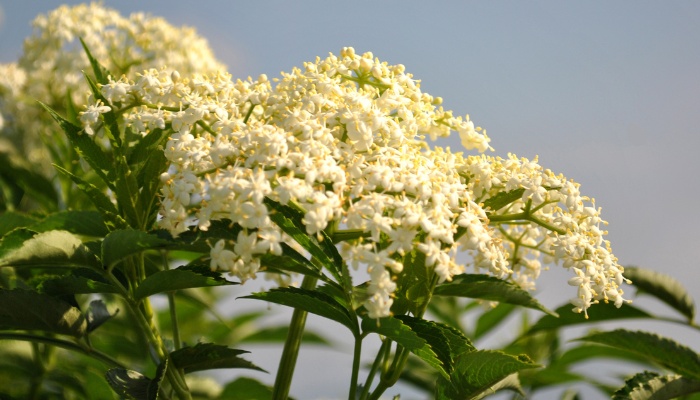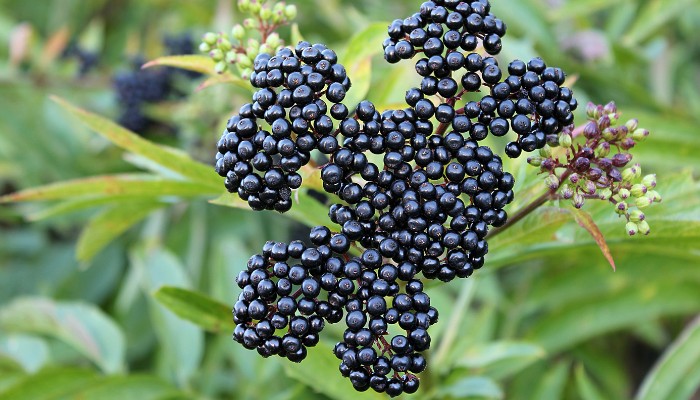For centuries, the elderberry species (Sambucus spp.) has been a renowned source of antioxidants and stress relief, as well as being recognized for its ability to reduce inflammation.
Foraging for your own can be a great activity to get outdoors, but be cautious of look-alikes that don’t contain the same level of beneficial vitamins and minerals.
Some look-alike varieties are highly toxic to humans, so be cautious, and use the guide below to familiarize yourself with these varieties.
Pokeweed (Phytolacca Americana)

While they bloom in spring and have dark purple berries just as elderberries do, the berries grow differently on pokeweed plants.
Their berries grow from a single stem instead of multiple ones, and they don’t have compound leaves, which makes them easier to identify among similar varieties.
Habitat
Pokeweed plants are commonly found growing in the same places as elderberries, and you will see them in pastures, near forest lines, along roads, and in forest openings. Birds are their main dispersal method, so they spring up in many places.
Appearance & Size
Pokeweed commonly grows to be about 10 feet tall with purple or bright red stems and leaves that are larger than elderberries.
Growing as a single plant in most situations, it may also grow in groups of many plants that resemble a shrub.
Leaves
The singular leaves are large, sometimes reaching 1 foot long. They are not compound and have an alternate spacing with smooth, oblong, lanceolate-shaped leaves.
Flowers & Berries
Pokeweed blooms with white flowers from May through October. The flowers mature into black berries on elongated clusters in late summer and early fall.
Devil’s Walking Stick (Aralia spinosa)

The most obvious difference between elderberries and the Devil’s walking stick is thorns. While they aren’t always as prominent on the smaller younger branches, check the main stem for medium-sized thorns.
Habitat
The Devil’s walking stick prefers to grow in deciduous forest lines; near streams, lakes, rivers; and in wide-open pastures.
Appearance & Size
You can find Devil’s walking stick growing as a woody deciduous shrub about 10 to 15 feet tall. Look for thorns at the node of each branch that gives this shrub its devilish appearance!
Leaves
Compound alternate-spaced foliage is toothed and considered the largest compound leaf in North America! The leaves will grow to be 2 to 5 feet long and wide. While shrubby in growth, its leaves are usually focused toward the top of the canopy.
Flowers & Berries
Its flowers and berries are very similar to elderberries, but the clusters of flowers are usually upright rather than hanging as they are in some elderberry species. Flower clusters are 3 to 4 feet wide and are covered in many creamy white flowers.
Water Hemlock (Cicuta spp.)

The USDA lists water hemlock as the most violently toxic plant growing in North America. Its name correlates to the cicutoxin toxin, which is the main ingredient that causes the shutdown of the central nervous system. Be sure to steer clear of this poisonous plant!
Habitat
As its name hints, water hemlock prefers areas of heavy moisture in meadows, pastures, and along streams. It can grow away from highly moist areas but won’t thrive as much and can look slightly different with a smaller stature and appearance.
Appearance & Size
Its branches are red or green, and they grow on tall, upright singular stems anywhere from 3 to 7 feet tall. Its leaves resemble celery and are commonly mistaken for Queen Anne’s Lace, but both are poisonous, so beware!
Leaves
Smaller alternate leaves are pinnately compound and can reach 2 to 4 inches in length. They are sharply toothed and lanceolate in shape.
Flowers & Berries
Umbels of white flowers grow on tall stems about 4 to 6 feet in height. They produce brown seed pods from purple berries that are extremely similar in appearance to elderberries.
Elderberry Identification

Generally found throughout Europe and North America, this plant is coveted for its berries and ornamental attributes.
All look similar and provide some healing benefits, but in most cases, when you hear the word elderberry, it refers to the European species.
Habitat
You’ll find elderberry species growing in the woodlands and forests, near water, and popping up in open fields and along the roads. It is a weedy species, so it isn’t finicky when it comes to finding a place to grow.
Appearance & Size
Elderberry is found growing as a medium to large shrub that will spread out and have a shapeless appearance. Some can grow as small trees over time.
Leaves
A characteristic of the species is oblong compound leaves with 5 to 7 leaflets per side. You’ll notice that the leaves have small serrations along the edge and will be positioned opposite from each other on the stem.
Flowers & Berries
They normally have white flowers with dark blue or purple berries on red stems. The color of the berries will vary with the S. racemona variety having red berries and the S. cerulea variety having lighter blue berries.
Types of Elderberry
Elderberry species grow throughout North America, and many grow in Europe as well.
The European species holds the greatest amount of health benefits and was considered by Hippocrates, the father of medicine, to be a favorite healing plant.
While they all have beneficial medicinal properties, many are beloved for their double purpose of being a great ornamental species as well!
American Elderberry (Sambucus canadensis)
This species grows to be about 12 feet in height and is also commonly called black elderberry. It is the most common variety to be planted as a landscape species for its lush foliage and fragrant white flowers that attract birds.
Its fragrant white flowers bloom in early summer, and its dark purple berries usually ripen in August or September.
European Elderberry (Sambucus nigra)
A larger growing variety that can become a small tree as it matures, the European elderberry will reach about 20 feet tall at full maturity.
It has fragrant pink or white flowers that turn into purple berries. Sometimes its foliage will also have a purple hue to it making it easily distinguishable from the American Elderberry.
Red Elderberry (Sambucus racemona)
Its bright red berries set this variety apart from the others! This species will grow into a small tree or shrub about 9 feet tall at maturity. Its stems are also red, bearing somewhat fragrant or non-fragrant white flowers.
Tell this species apart from the others by crushing its stems and leaves — they are known to smell unpleasant when crushed.
Blue Elderberry (Sambucus cerulea)
Also commonly known as the Mexican Elderberry, this variety will bloom with white flowers that mature into bright blue berries.
Resembling small grapes or blueberries, these make this an easy-to-spot species. The berries grow in heavy clusters on large shrubs about 8 to 12 feet tall.
Conclusion
Take some time to get to know a plant if you’re going to forage for it! It will help to identify it in the field quickly and also make you aware of what varieties you should avoid.
Hopefully, this guide can help you determine the different varieties. Foraging can be fun, but if you’re ever on the fence about its toxicity, leave it!
